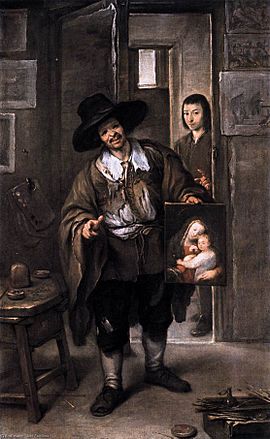Spanish Baroque painting facts for kids
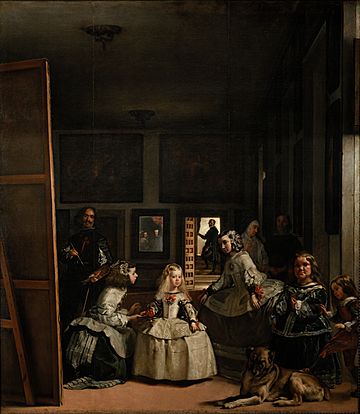
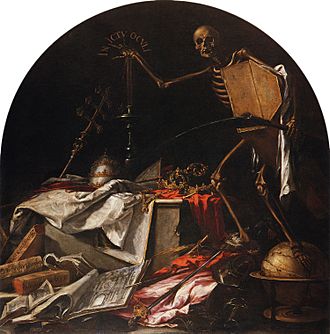
Spanish Baroque painting is a special art style that grew in Spain during the 1600s and early 1700s. It started in the early 17th century. This style was a reaction against earlier art that was too perfect or distorted.
The main goal of Baroque painting was to make scenes easy for people to understand. Artists used very realistic details. They also followed rules from the Catholic Church, especially during the Counter-Reformation. This was a time when the Church wanted to bring people back to Catholicism.
Artists in Spain were inspired by Italian painters like Caravaggio, who used strong shadows and light. This style became very popular in Spain after 1610. Spanish painting was also influenced by art from Flanders (part of today's Belgium), which Spain ruled at the time.
When the famous Flemish painter Peter Paul Rubens visited Spain, his art had a big impact. Later, his style mixed with the loose brushstrokes of the Italian painter Titian. This blend helped create the amazing works of Diego Velázquez, who was the most important artist of this period.
Later in the 17th century, more Italian artists came to Spain. This led to a very lively and new style of Baroque art. Even though Spain faced tough times, this period is known as the Spanish Golden Age. This is because so many talented and original artists created world-class paintings.
Contents
What Makes Spanish Baroque Painting Special?
Who Paid for the Art?
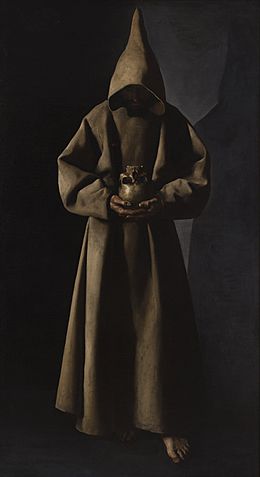
The main people who bought paintings were the Catholic Church and groups linked to it. People also ordered paintings for their church chapels. Religious paintings were very important because the Church used them to teach and inspire during the Counter-Reformation.
Painters working for the Church had to follow strict rules. The Church leaders decided what the paintings should show and how. Sometimes, contracts even said which older paintings the artist had to copy. The Church had to approve the final artwork.
Working for the Church gave artists good money and a chance to become famous. Their art was shown in public places.
The Royal Family also ordered many paintings. Philip IV of Spain was a great supporter of art. The painter Peter Paul Rubens wrote in 1628 that King Philip IV loved painting and visited him every day.

A new palace, the Buen Retiro Palace, needed a lot of art. This led to many important art orders. Spanish painters decorated the Hall of Realms. Diego Velázquez painted portraits of the King on horseback. There were also paintings of the King's army victories and Francisco de Zurbarán's series about the Labours of Hercules.
Artists from other countries, like Claude Lorrain and Nicolas Poussin from Rome, also made paintings for the palace. Painters from Naples, like Giovanni Lanfranco, created over thirty paintings about Roman history. One of these was Women Gladiators by Jusepe de Ribera.
Because paintings could not be moved between royal palaces, and the King's minister, Gaspar de Guzmán, Count-Duke of Olivares, wanted the palace finished quickly, many artworks were bought from private owners. About 800 paintings ended up on the palace walls. Velázquez himself sold some paintings to the King, including his own works and others.
How Artists Gained Respect
While famous artists worked for the Church or the King, many other artists sold their paintings in shops or on the street. Painting was often seen as a manual job, like a craft. This meant painters were not paid well and did not get much social respect.
This view only started to change in the 1700s. Throughout the 17th century, painters worked hard to have their job seen as a "liberal art," like writing or philosophy. Velázquez tried to join the Order of Santiago, a knightly order, to gain more social standing. Many art books from this time also tried to show that painting was a dignified profession.
What Did They Paint?
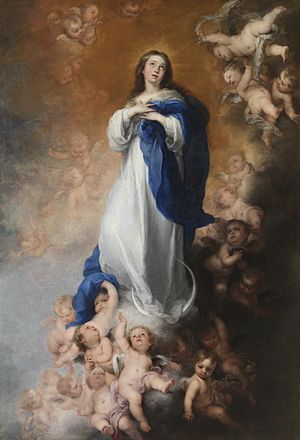
Religious Art
Francisco Pacheco, who taught Velázquez, believed that art's main purpose was to inspire religious feelings. This is why realism became so important in religious painting. It helped people feel closer to the religious stories shown.
During this time, the Church encouraged paintings of the Virgin Mary and Saint Joseph. The Immaculate Conception (Mary being born without sin) was a very popular subject in Spain. Spain, led by its kings, strongly defended this idea, even before the Pope officially made it a church teaching.
Paintings about the Holy Communion and the Eucharist also became very important. Scenes from the Gospels were common, often used to fight against Protestant ideas. For example, the Last Supper showed the Eucharist. Christ's miracles showed acts of kindness.
There were very few paintings from the Old Testament. The ones that were painted usually hinted at the birth of Christ or were similar to his suffering, like the story of Abraham and Isaac.
Everyday and People Paintings

Other types of paintings, like still life and portraits, also became popular. Spanish artists developed their own unique style for these. The term "still life painting" was used as early as 1599.
Spanish still life paintings were often simple and serious. They were different from the rich and detailed Flemish ones. Artists like Juan Sánchez Cotán created still lifes with clear shapes, strong lines, and dark backgrounds. Many other painters followed his style.
The Seville School, with Velázquez and Zurbarán, also helped define the Spanish still life. While early Spanish still lifes were simple, later ones showed more Flemish influence. They became richer and more complex, sometimes including hidden meanings. Examples include flower paintings by Juan de Arellano and Vanitas paintings (showing life's shortness) by Antonio de Pereda and Juan de Valdés Leal.
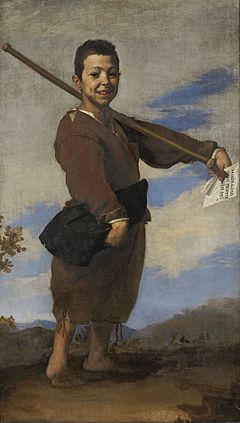
Spanish Baroque portraits were very different from the fancy portraits made for other European kings. El Greco helped shape this style. Spanish portraits were influenced by Italian art (like Titian) and Flemish art.
These portraits were simple, with few decorations. They showed the true feelings and honor of the person. Unlike other art of the time, these portraits treated everyone the same, whether they were kings or street children.
Spanish Baroque portraits are known for being serious and showing the true "soul" of the person. They often showed a bit of doubt or acceptance of fate. Artists used natural details, not perfect, ideal ones. The real was more important than the ideal.
Velázquez, Ribera, and Zurbarán made magnificent portraits throughout the 17th century. This style continued until the time of Francisco Goya.
Paintings about historical events or myths were also made, but less often. Over time, more mythological paintings were created not just for royal homes, but for a wider audience.
Landscape paintings were considered less important by art writers. They thought paintings of people were the most important. Vincenzo Carducci, an art writer, said landscapes were only good for country houses. He said their value would increase if they included religious or historical scenes.
However, art collectors really liked landscape paintings. It's hard to know how many were by Spanish artists or imported, as records often didn't say. Unlike in the Netherlands, Spain didn't have many artists who specialized only in landscapes. One exception was Ignacio de Iriarte, who worked in Seville. Other painters like Francisco Collantes and Benito Manuel Agüero in Madrid, and Antonio del Castillo y Saavedra in Cordoba, were also known for their landscapes.
See also
 In Spanish: Pintura barroca de España para niños
In Spanish: Pintura barroca de España para niños
- Spanish art
- Baroque painting
- Spanish Golden Age
- Spanish Renaissance
- Spanish Baroque architecture
- Spanish Baroque literature


